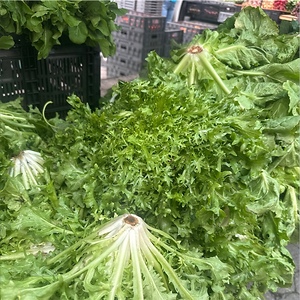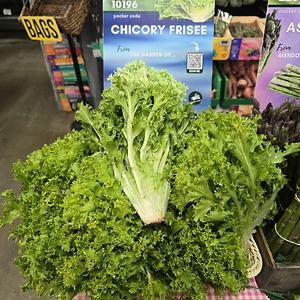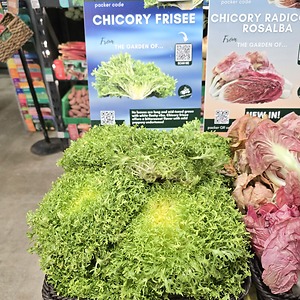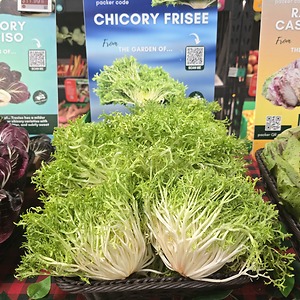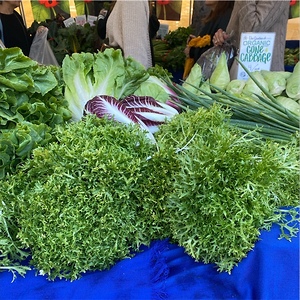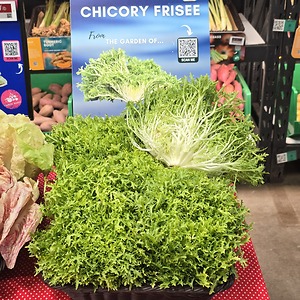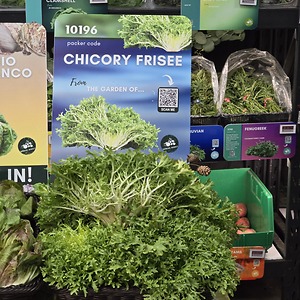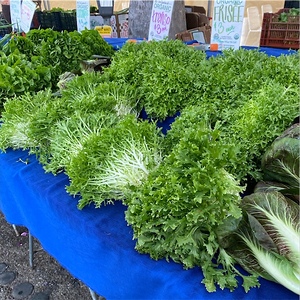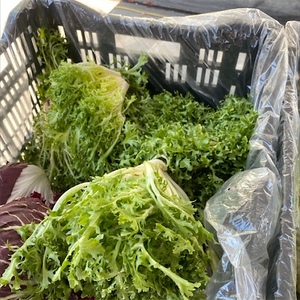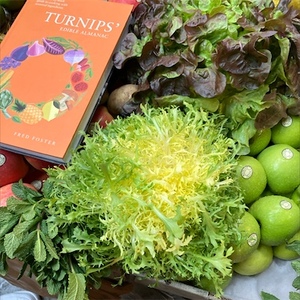


Frisée
Estimated Inventory, 24 ct : 0
Description/Taste
Frisée is comprised of a loosely formed, flattened rosette that varies in size depending on growing conditions and the maturity of the leaves at harvest. The leaves grow from a shared central base at the bottom of the rosette and each leaf is narrow, lobed, and serrated. Frisée leaves are known for their frilly, airy texture and are often slightly curled. The leaves range in color, which is altered by growing methods, and typically appear pale green on the exterior portions of the rosette, while the interior leaves are white and yellow. Raw Frisée leaves have a crisp, crunchy, and lightly chewy consistency. Younger leaves and leaves at the heart of the rosette are the most tender with a delicate succulent crunch. Cooked leaves will also soften. Frisée is edible raw or cooked and has a subtly bitter, nutty, and peppery flavor.
Seasons/Availability
Frisée is available year-round, with a peak season in the late winter through early spring.
Current Facts
Frisée, botanically classified as Cichorium endivia var. crispum, is a cultivated culinary species belonging to the Asteraceae family. The name Frisée translates from French to mean “curly” and was given to the species as a commercial moniker for its narrow, frilled leaves. Frisée is a type of endive and is a part of the chicory family. The species is also known as Curled Endive, Curly Endive, and Curly Chicory in English, Chicorée Frisée in French, Escarola Crespa in Spanish, and Indivia Riccia in Italian. Frisée greens grow in loosely formed rosettes and are a hardy but labor-intensive crop. When the plants are almost fully grown, the leaves are covered, tied up in bunches, or hidden by boards and containers to block out sunlight. This process is known as blanching. Blocking sunlight allows Frisée greens to maintain a milder and less bitter flavor and the leaves develop their signature pale green, yellow, and white hues. If left to grow in full sun, the leaves would become dark green and develop a very bitter, often unpalatable taste. There are many varieties of Frisée grown worldwide and popular types include Grosse Pommant Seule, Grosse Pancalière, Frisée de Meaux, Gloire de L'Exposition, D'hiver de Provence, Très Fine Maraîchère, and Wallonne. Frisée is cultivated as a specialty green worldwide and the subtly bitter leaves are favored for adding texture, volume, coloring, and flavor to culinary dishes. The greens can be utilized raw or cooked and are commercially grown and planted in home gardens.
Nutritional Value
Frisée is a source of vitamins A, C, K, and B9. Vitamin A helps to maintain the overall health of organs, while vitamin C strengthens the immune system. Vitamin K assists the body in producing various proteins to support bones and vitamin B9, also known as folate, helps the body produce genetic material and create new cells. In addition to vitamins, Frisée contains manganese to help with daily brain functions, potassium to balance fluid levels, and calcium to build bones and teeth. Frisée is also occasionally used in natural medicines as a cooling, anti-inflammatory ingredient, said to improve digestion, circulation, and overall skin health.
Applications
Frisée has a subtly bitter, peppery, and nutty taste suited for fresh and cooked preparations. The greens are valued for their distinct frilled appearance, adding volume, texture, and flavor into dishes. The lobed, curled leaves also help to grab dressings and sauces to evenly coat salads and other recipes. It is recommended to tear the leaves into smaller pieces than cut to help preserve their light and airy feel. The leaves can also discolor, turning brown or yellow, so dishes should be dressed just before serving. Frisée is known for its use in salads or as an edible garnish. The greens can be dressed in rich, heavier sauces and dressings, and they can be served with other hearty ingredients to create a well-rounded, complex dish. Frisée can also be stuffed into sandwiches or served in egg-based dishes, especially with poached eggs. Beyond fresh preparations, Frisée leaves hold their shape when cooked and are popularly blanched, sauteed, simmered, wilted, or braised. The greens can be cooked into pasta dishes, casseroles, or simply sauteed with garlic and mushrooms as a side. The leaves can also accompany meat main dishes. Frisée pairs well with fruits such as pomegranate seeds, pears, citrus, apples, and peaches, herbs including basil, parsley, dill, and chervil, maple syrup, almonds, pumpkin seeds, and cheeses such as blue, feta, goat, and Manchego. Unwashed Frisée greens will keep for around five days when stored wrapped in a paper towel and placed in a sealed container in the refrigerator.
Ethnic/Cultural Info
Frisée is famously incorporated into salade Lyonnaise, a favorite dish served at bouchons in the Lyon region of France. Lyon is often regarded as the capital of French gastronomy and is nicknamed “the belly of France” for its reputation of utilizing local ingredients and combining them together to make internationally recognized dishes. Within Lyon, bouchons are small family-owned and operated restaurants that are unique to the region. These establishments were thought to have been created from 17th and 18th century inns who served hearty meals to travelers and traders. These inns and taverns were also rumored to have hung bundles of straw or sticks to their doors and signs, a symbol that horses could be cleaned and stabled for the night. The French word bouchonner roughly translates to mean “to rub down” and this term was often used as a descriptor for these establishment’s horse services. Bouchonner eventually became shortened to bouchon, and the name is still used for these restaurants in the modern day. In bouchons, salade Lyonnaise is a prevalent dish comprised of Frisée, poached eggs, bacon, and onions in a mustard-vinegar dressing. The first written recipe for salade Lyonnaise was recorded in 1873 in the book “Grand Dictionnaire Universel du Xixe Siècle” translating to the “Great Universal Dictionary of the 19th Century,” published by Pierre Larousse. There are many theories and legends surrounding the creation of this dish, and since its rise to fame within bouchons, salade Lyonnaise has become a local specialty throughout Lyon, France.
Geography/History
Frisée is a descendant of wild, ancient chicory varieties that are thought to have origins in Southeastern Europe and Southwestern Asia. In Europe, chicory historically grew wild in the Eastern Mediterranean and in Asia, the species was found in areas of the modern-day Middle East. Much of the history of when the ancient species was spread into other parts of Europe and Asia is unknown, but over time, chicory varieties were said to have been present among the Ancient Egyptian, Greek, and Roman Empires. Types of chicory was later cultivated in the Mediterranean, selectively breeding varieties for increased culinary appeal. Frisée is thought to have been created from cultivation and became a specialty green grown for its distinct characteristics. It was also introduced to the United States in the late 20th century as a popular salad green. Today, Frisée has expanded in production worldwide and is being grown commercially and in home gardens. The species widely cultivated in Europe, especially in France, Italy, the Netherlands, and Belgium, and is also produced throughout areas of Central and South America for commercial export. Frisée is typically sold through select grocers, wholesalers, and local markets as a fresh culinary ingredient.
Recipe Ideas
Recipes that include Frisée. One



